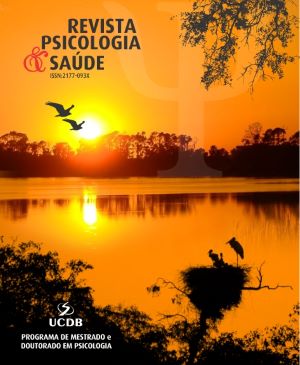Mothers of Newborns with external Congenital Malformation: Emotional Impact
DOI:
https://doi.org/10.20435/pssa.v13i3.1067Keywords:
mother-child relationship, congenital abnormalities, emotional experiencesAbstract
Introduction: A malformed baby (with defect in an organ or body part) can damage the mother/baby bond. We investigated the emotional impact experienced by mothers of newborns with external congenital malformation (MF). Method: Qualitative research carried out in a high fetal risk reference institute in Rio de Janeiro, based on semi-structured interviews with five mothers, in the prenatal and 15 days after delivery. The analysis was content. Results: The diagnosis of the child's MF during pregnancy: the conflict between the invisible reality of the malformation and the desire for normality (how he dealt with the news/what to expect after birth); The visibility of MF: between fantasy and reality (concretion of the diagnosis); ambivalence in the bond: prejudice and death wish (feelings/desires). Conclusion: A baby with external MF influences the formation of the mother/baby bond, and it is necessary to train the team.
References
Baldissarella L., & Dell'Aglio D. D. (2009). Within the limits of life and death: A case study on the parents/baby relationship in a neonatal ICU. Estilos da Clinica, 14(26), 68-89. Recuperado de http://pepsic.bvsalud.org/scielo.php?script=sci_abstract&pid=S1415-71282009000100005&lng=es&nrm=iso&tlng=en DOI: https://doi.org/10.11606/issn.1981-1624.v14i26p68-89
Battikha E. C., Faria M. C. C., & Kopelman B. I. (2007). The Maternal Representations about a Baby who is Born with Serious Organic Diseases. Psicologia: Teoria e Pesquisa., 23(1):17-24. doi: http://dx.doi.org/10.1590/S0102-37722007000100003 DOI: https://doi.org/10.1590/S0102-37722007000100003
Bomfim O. L., Coser O., & Moreira M. E. L. (2014). Unexpected diagnosis of fetal malformations: Therapeutic itineraries. Physis, 24(2), 607-622. doi:http://dx.doi.org/10.1590/S010373312014000200015 DOI: https://doi.org/10.1590/S0103-73312014000200015
Câmara R. H. (2013). Content analysis: From theory to practice in social research applied to organizations. Revista Interinstitucional de Psicologia, 6(2), 179-91. Recuperado de http://pepsic.bvsalud.org/scielo.php?script=sci_abstract&pid=S1983-82202013000200003&lng=pt&nrm=iso&tlng=en
Fontes C. M. B., Menezes D. V., Borgato M. H., & Luiz M. R. (2017). Communicating bad news: An integrative review of the nursing literature. Revista Brasileira de Enfermagem, 70(5), 1089-1095. doi:http://dx.doi.org/10.1590/0034-7167-2016-0143 DOI: https://doi.org/10.1590/0034-7167-2016-0143
Gomes R. (2002). A análise de dados em Pesquisa Qualitativa. In M. C. S. Minayo (Org.), Pesquisa Social: Teoria, Método e Criatividade (pp. 67-74). Petrópolis, RJ: Vozes.
Gonçalves T. G., Xavier R. B., Araújo L. M., & Arial L. F. (2011). Nursery’s contribution to the bonding process between mother and infant with inborn malformation. Revista de Pesquisa: Cuidado é Fundamental, 3(2), 1776-90. Recuperado de https://www.redalyc.org/pdf/5057/505750888002.pdf
Guerra F. A. R., Llerena Jr. J. C., Gama S. G. N., Cunha C. B., & Theme, M. M. Filha (2008). Birth defects in Rio de Janeiro, Brazil: An evaluation through birth certificates (2000-2004). Cadernos de Saúde Pública, 24(1), 140-9. doi:http://dx.doi.org/10.1590/S0102-311X2008000100014 DOI: https://doi.org/10.1590/S0102-311X2008000100014
Junqueira M. F. P. S., Telles D. C. L., Morsch D. S., & Deslandes S. F. (2006). Os desafios da humanização em uma UTI Neonatal Cirúrgica. In S. F. Deslandes (Org.), Humanização dos cuidados em saúde: Conceitos, dilemas e práticas (pp. 261-282). Rio de janeiro: Editora Fiocruz.
Lamego D. T. C., Deslandes S. F., & Moreira M. E. L. (2005). Challenges for humanization of care in a surgical neonatal intensive care unit. Revista Ciência & Saúde Coletiva, 10(3), 669-675. doi:http://dx.doi.org/10.1590/S1413-81232005000300023 DOI: https://doi.org/10.1590/S1413-81232005000300023
Machado, M. E. C. (2012). Couples that receive a prenatal diagnosis of fetal malformation: A thought about the role of Hospital Psychologists. Revista Sociedade Brasileira de Psicologia Hospitalar, 15(2), 85-95. Recuperado de http://pepsic.bvsalud.org/scielo.php?script=sci_abstract&pid=S1516-08582012000200007&lng=pt&nrm=iso&tlng=en
Marciano, R. P. (2017). The maternal representations about a premature baby. Revista Sociedade Brasileira de Psicologia Hospitalar, 20(1), 143-164. Recuperado de http://pepsic.bvsalud.org/scielo.php?script=sci_arttext&pid=S1516-08582017000100009 DOI: https://doi.org/10.57167/Rev-SBPH.20.236
Mathelin, C. (1999). O Sorriso da Gioconda: Clínica psicanalítica com os bebês prematuros. Rio de Janeiro: Companhia de Freud.
Minayo, M. C. S. (2010). O desafio do conhecimento. In Pesquisa Qualitativa em Saúde (pp. 261-297). São Paulo: Hucitec.
Santos, S. R., Dias, I. M. A. V., Salimena, A. M. O., & Bara, V. M. F. (2011). The existence of the parents of a child with congenital malformation. Revista Mineira de Enfermagem, 15(4), 491-97. Recuperado de http://www.reme.org.br/exportar-pdf/62/v15n4a04.pdf/
Silva, L. L. T., Madeira, A. M. F., Oliveira, C. G., Lima, S. C. S., & Campos, T. M. F. (2013). Parents of babies malformados: An existential approach. Revista de enfermagem Centro-Oeste Mineiro, 3(3), 770-779. Recuperado de https://pesquisa.bvsalud.org/portal/resource/pt/bde-25561
Stellin, R. M. R., Monteiro, C. F. A., Albuquerque, R. A., & Marques, C. M. X. C. (2011). Processes of mothering construction motherhood and feminity: Psychic resources for the practice of motherhood in its singularities. Estilos da Clinica, 16(1), 170-185. Recuperado de http://pepsic.bvsalud.org/scielo.php?pid=S1415-71282011000100010&script=sci_abstract&tlng=en DOI: https://doi.org/10.11606/issn.1981-1624.v16i1p170-185
Victoria, C. G., Knauth, D. R., & Agra Hassen, M. N. (2000). A construção do objeto de pesquisa. In Pesquisa Qualitativa em Saúde: Uma Introdução ao Tema (pp. 45-51). Porto Alegre: Tomo Editorial.
World Health Organization. (2016). Congenital anomalies. Fact sheet 370. Recuperado de http://www.who.int/mediacentre/factsheets/fs370/en/
Published
How to Cite
Issue
Section
License
The articles published on journal Psicologia e Saúde holds the copyrights of all texts published by it. Due to that, there is a demand for a letter of copyright cession (see Appreciation). The full reproduction of any article of this Journal in other publications, by any means, requires a written authorization of the Editorial Board. Partial reproductions of articles (abstracts, more than 500 words of text, tables, pictures and other illustrations, sound files) should have the written permission of the Editorial Board and the Authors.












